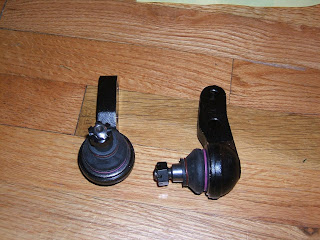 1) The interior carpet is pretty dirty
1) The interior carpet is pretty dirty2) The insulation under the carpet looks old and ratty (at least, near the edges)
3) The carpet smells pretty bad. Actually, very bad...
Removing the driver and passenger seats involves removing four fasteners per seat. These fasteners are round-headed allen wrench types, and require a 7mm (?) allen wrench to remove. Once all four fasteners are removed, fold the seat and remove from the car. My seats were spaced with four 15mm or so plastic spacers. Make sure not to lose those.


The passenger seat worked the same way. However, due to space constraints, I had to remove it through the driver side. Although nothing bad happened, I would recommend not doing this if possible - it is annoying and difficult to get a good handle on things.
Removing the seatbelts was also very straightforward. I only removed the bottom anchors andleft the top anchor fastened to the side rear wall. My belts are old and somewhat frayed, so I think I'll replace those also.

The door sill trim plates do not need to be removed completely, but they need to be loosened up so that one can pull out the carpet from under them. They are held in place by four metal sheet screws. On my car, the screws use a square thread on the head, which required a few trips to the hardware store to get the proper-sized square key.
The E-brake boot comes out by pulling it. In the process, the boot itself fell apart. Again, another thing to replace. I may also pull out the e-brake assembly, just to clean it and refurbish it. Again, scope creep makes an appearance.

The rear seat plates are these L-strips of chromed metal which are screwed in place in the rear. Removing them is straightforward, but the strips' edges are sharp, and I ended up cutting myself ("it's just a flesh wound!") Very annoying!

Once all this is done, one just pulls out the carpet. The carpet is a single shaped piece, so pulling it requires a bit of finesse. Start from the farthest edge, pull back and fold towards yourself, then pull the near edges, fold away towards the rest of the carpet, and pull the whole "roll" out of the car.
Removing the carpet uncovered the insulation batting underneath. In my car, this looked very nasty - dirty, rusty, dusty, and just plain old. The batting seems to be made of cloth fabric, with a layer of bitumen/tar on top. My impression was that it was a pretty good quality piece, kinda like 40 year-old dynamat, with a 3/4 inch layer of fabric attached to it.
However, pulling the insulation batting would cause the top bitumen layer to crack. It also unleashed a dust storm inside the car. (Take the proper precautions if you ever do this.)
 After trying to remove the insulation carefully, I realized I'd be throwing the old thing away anyways, as it was way too dirty and smelly, and the cracking of the bitumen was pretty much widespread. So I just started pulling the stuff without much regard for reusing it. It all folded compactly, and ended up going straight to the trash bag.
After trying to remove the insulation carefully, I realized I'd be throwing the old thing away anyways, as it was way too dirty and smelly, and the cracking of the bitumen was pretty much widespread. So I just started pulling the stuff without much regard for reusing it. It all folded compactly, and ended up going straight to the trash bag.Underneath, I found a few things:
1) Lots of dirt - mostly dust from the insulation batting. I had to vaccum-clean and use wet rags to clean up the interior, and it came out OK.
2) No rust, just fresh red paint. This is good news, as any major rust under the carpeting would require major rebuilding measures

3) A bent floor pan area at the driver side foot well. This occured a few months back, when the driver side jacking point bent inwards. This will require a few strong sledge whacks, some welding, and a bit of paint. Fortunately, this all happens under the car, so the visible finish will not be affected.
After all this was done, I re-installed the driver seat. This allows me to drive the car in its current half-baked state. The interior looks a bit like a race car's, and driving it is even noisier. But this will allow me to drive the car to the shop to repair the jacking point/bent floorpan, and in case I need their help with anything else.







































